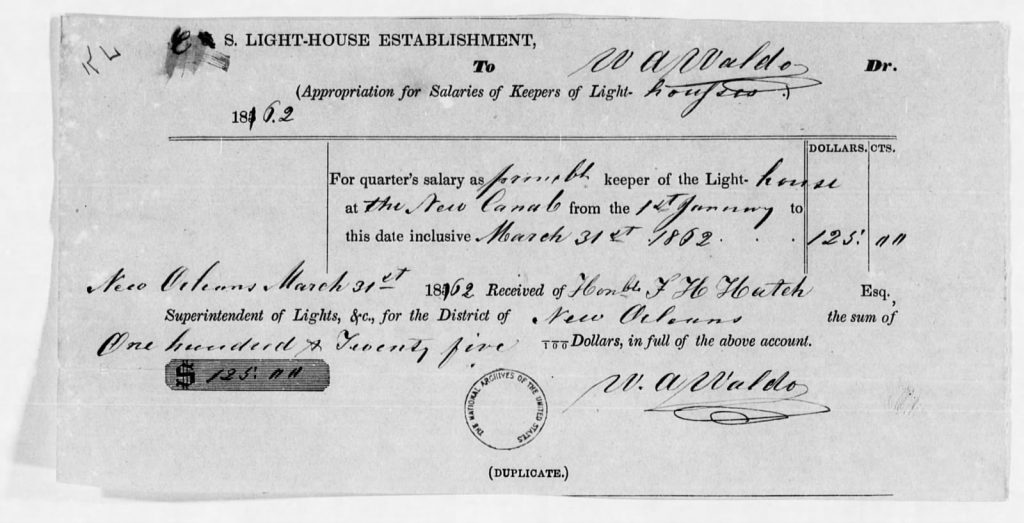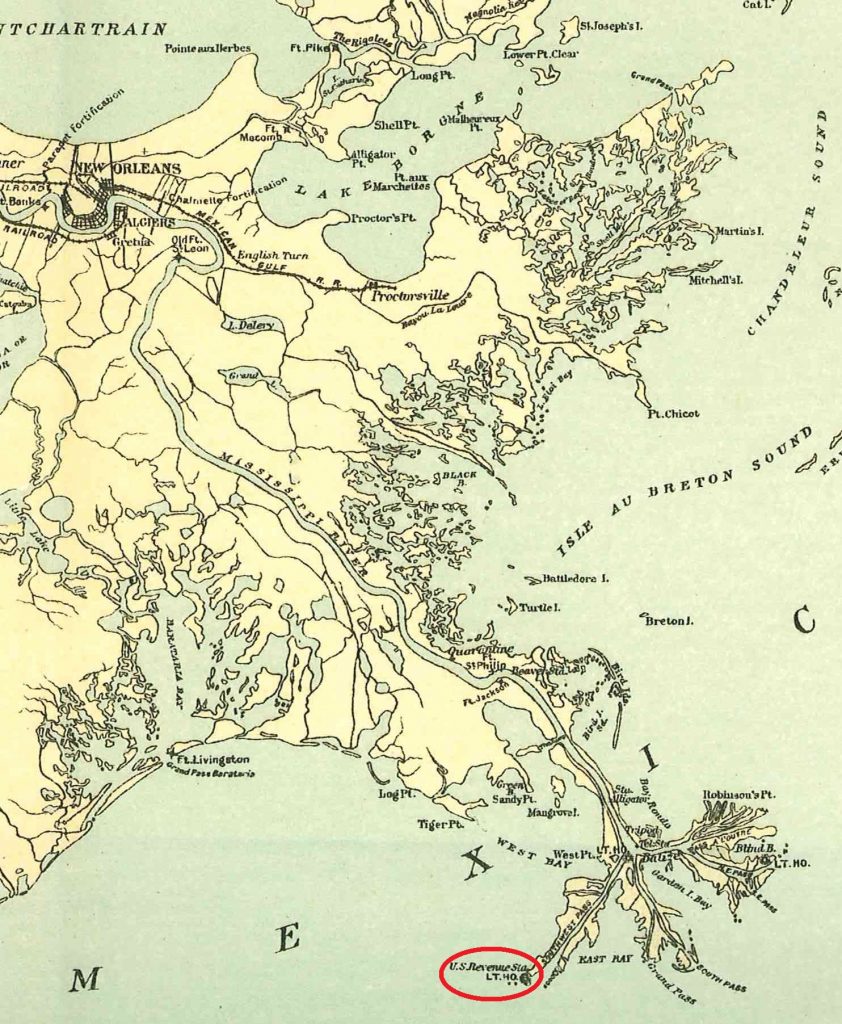Loyalty in a Lighthouse on the Confederacy’s Fringe
Loyalty consistently emerges when studying the U.S. Civil War. Would someone remain loyal to the United States or support the Confederacy? Would they join their native state or family? Would they honor sworn oaths? For many, what side to support was a foregone conclusion, but others struggled with conscience and identity. For lighthouse keeper Manuel Moreno, loyalty was a personal struggle between three governments, family, geography, and circumstances, and it is still unclear just where his loyalties lay as the Civil War escalated.
Even in normal circumstances, nineteenth century lighthouse keepers faced hardships, typically residing alone or with their immediate family far from urban centers exposed to the elements. Keeper positions were political appointments that meant steady work to those who could withstand these challenges.

Manuel Moreno was just such a keeper, caretaker of the Southwest Pass lighthouse, a small house and 68-foot white tower that held a single continuously illuminated light visible for fifteen miles. This was one of four lights at the Mississippi River’s delta – lighthouses were also at the Balize/South Pass (abandoned and inactive since the 1820’s), Pass à l’Outre, and at the Head of Passes where these channels converged.[1]
Moreno was appointed Southwest Pass light keeper in August 1860, living there with an assistant and his “large family” including three women and two children. They staved off two hurricanes in September and October 1860 that damaged the station, breeching a wall. “Two thirds of the time,” Moreno observed, the structures were “covered with water which finds its way into the house and into the light house.”[2]
His immediate bosses were district lighthouse inspector Lieutenant Joseph Fry, USN, and district lighthouse superintendent and New Orleans customs collector Frank Hatch. With Louisiana’s secession, Moreno and his fellow keepers entered new jurisdiction. Within weeks jurisdiction shifted again to the Confederacy. Fortunately for Moreno, both Hatch and Fry maintained their positions, providing consistency in unprecedented times. Moreno took the new jurisdiction as opportunity to press for repairs to his charge from the previous year’s storms. He openly boasted: “I have always been, as I am now, as good Democrat and in favor of Southern rights as anyone, and shall continue so to be,” before noting that the light’s “dangerous condition of affairs could be easily remedied by … erecting a strong fence around it.”[3]

Adjusting to the new jurisdiction, Moreno took a pro-Confederate stance, recommending that his lighthouse “ought to have about six muskets & few pistols … so as to be ready at all times to resist any attack.” With such weapons, Moreno claimed he and his assistant could “repulse a large number of men by firing through the high windows of the light house.”[4]
The proclaimed loyal Manuel Moreno continued illuminating Southwest Pass light, even as U.S. blockaders arrived. Lieutenant David D. Porter’s USS Powhatan began blockading Southwest Pass on June 1, 1861. At the end of June, Porter ordered two forays to the Southwest Pass lighthouse. The first included a boat of 15 officers and sailors who “acted in a gentlemanly manner,” promising to “hurt no one.” The second a few days later was by the same officers searching for oysters. Reporting the incident, Moreno explained he “could not resist them from landing, not being prepared with the necessary weapons to do so.”[5]
Days after Powhatan’s crew visited Southwest Pass light, Commander Raphael Semmes appeared with CSS Sumter, hoping to escape the blockade. The small privateer-turned-Confederate gunboat Ivy, commanded by none other than Lieutenant Joseph Fry, Moreno’s superior and local light inspector, was also present guarding the river’s channels. Fry informed Semmes on June 21 that USS Powhatan had temporarily abandoned the blockade of Southwest Pass. Semmes immediately dispatched a boat to Southwest Pass light to procure a pilot to safely take him out of the river via that channel. Moreno “knew nothing of the pilots,” Semmes remembered, “and was unwilling to come on board, himself though requested. The night wore away, and nothing could be done.”[6]

The next morning Powhatan was back on station and Semmes continued preparations to escape, extinguishing the Pass à l’Outre light. Moreno’s Southwest Pass light remained illuminated, but only displaying its light upstream to assist Semmes should he try to escape that way. Instead, Semmes escaped the Mississippi River via Pass à l’Outre on June 30, 1861, starting his memorable commerce raiding career.
Since Moreno’s light was illuminated “only to show from up the river,” Lieutenant Porter responded to the embarrassment of Sumter’s escape by placing it out of commission. “I have ordered the apparatus at South West Light-House to be taken down and brought on board,” Porter wrote on July 4, 1861.”[7] The next day a boatload of “well armed” sailors landed and removed Southwest Pass light’s “oil, wicks, Lens and Lamps.” “All my resistance was in vain,” Moreno wrote Hatch in New Orleans.[8] USS Powhatan’s log recorded the party was ashore for five hours, returning with “all the apparatus for lighting the light-house at the South West Pass, including the lenses.”[9]
As Powhatan’s boat departed, Moreno realized he was out of a job. Suspecting he would be discharged from his duties, Moreno wrote district superintendent Hatch pleading that “I am still in possession of the buildings and I intend to remain here … I hope that our Salary will not be discontinued, for the truth is, that the small amt I draw from the Custom House is the only dependence I have for the support of my large family … I am willing to remain here and ready to work.” He added, perhaps hoping to showcase his Confederate loyalty: “I do sincerely hope that our Confederate forces will soon redeem the above described property and inflict the deserved punishment upon the aggressors.”[10]
Moreno had reason to worry about his job. With lights extinguished, Hatch ordered his light keepers discharged. By the end of July, the stations were stripped of remaining supplies.[11] Southwest Pass light’s assistant keeper departed, but with no job, no income, and possibly a growing distrust of the Confederate government, the Moreno family remained. They were quickly “cut off from all intercourse with New Orleans.”[12]
The family soon became destitute and Moreno asked the blockaders for help. Lieutenant Porter began supplying “provision for the support of his family” and when USS Niagara replaced Powhatan, Captain William W. McKean was “obliged to do the same.” In mid-September 1861, Moreno was ordered to return to New Orleans. Perhaps suspecting he would be punished for receiving help from the blockaders, Moreno rowed out to USS Niagara on September 14 and pleaded to join them instead. Moreno claimed he was “obnoxious to the rebels on account of his Union sentiments, and his having refused to take the oath of allegiance to the Confederate States” and that his family was “very desirous of going North.” Captain McKean sent a boat to the lighthouse to remove Moreno’s family. They were brought to Fort Pickens, Florida, before being transported further north. The impression Moreno made with Niagara’s officers was so pronounced they collected “a small sum, for his use on his arrival at New York.”[13]

Was Moreno a loyal Confederate who took his chances with the enemy? Was he a Unionist who hid sympathies from his bosses upriver? Did his loyalties shift when the Confederacy’s lighthouse infrastructure collapsed? Was he an opportunist playing both sides?
We may never know Moreno’s true loyalties, but his circumstances with his family on the Confederacy’s fringe, isolated by geography and interacting with both sides certainly influenced him. I personally think Moreno was just trying to get by and take care of his family. When the Confederacy paid his salary, he was content to take their money and do his job. When discharged he turned to US blockaders to provide for his family. When he saw the chance to escape, he jumped at the chance to be taken north. Clearly, loyalty in the Civil War could be much more complicated than choosing which flag to hold.
Endnotes:
[1] Alexander G. Findlay, A Description and List of Lighthouses of the World: 1861, (London, 1861), 133.
[2] Moreno to Hatch, February 6, 1861, Reel 45, Confederate States of America Records, MSS16550, Library of Congress.
[3] Ibid.
[4] Carol Wells, “Extinguishing the Lights: 1861,” Louisiana History, Vol. 19, No. 3, (Summer 1978), 302.
[5] Moreno to Hatch, June 22, 1861, Confederate States of America Records.
[6] Raphael Semmes, Memoirs of Service Afloat, (Baltimore, 1869), 109.
[7] Porter to Mervine, July 4, 1861, ORN, Ser. 1, Vol. 16, 573.
[8] Moreno to Hatch, July 5, 1861, Box 88, Reel 45, Confederate States of America Records.
[9] Abstract Log of USS. Powhatan, July 5, 1861, ORN, Ser 1, Vol 16, 573.
[10] Moreno to Hatch, July 5, 1861, Confederate States of America Records.
[11] Wells, “Extinguishing the Lights,” 306-307.
[12] McKean to Mervine, September 14, 1861, Gulf Squadron, Letters Received by the Secretary of the Navy from Commanding Officers of Squadrons, M89, RG 45, US National Archives.
[13] Ibid.
Wow! Thank you for this wonderful nugget of Civil War “fringe” history — i just loved it … and what an impressive array of rather obscure primary sources … you’ve probably got an interesting detective story that led you to Mr. Moreno and the Southwest Lighthouse … can you share a little of how that happened in a comment? Thanks again for a great read!
Happy you enjoyed the write up! So I stumbled onto Moreno while diving into the “Squadron Letters” of the National Archives, the collection of letters sent by ship/squadron commanders to Navy Department Headquarters (footnote 12). After that I started digging into the lighthouse situation, found some mentions in other primary accounts, and then found the article in Louisiana History (footnote 4). That article provided lots of background info (thanks to Carol Wells for the awesome research there which also pointed me in the direction of the Library of Congress CSA records), which also mentioned a few other sources to look at. That article however did not mention the letter I found in the Navy’s documents in the National Archives. Thus, with something new to add to the conversation about Louisiana lighthouses I figured a write up for the blog was warranted.
thanks Neil … your story about the story is equally interesting … perhaps there’s a blog post there as well … you definitely did some slick detective work … well done and thanks again. PS — enjoyed the Shellback post as well.
Nice to meet you at the symposium. Do you have any information on what happened to the family after they reached the North!
It was great to see you at the symposium as well.
Unfortunately, that info is still up in the air. I could not find anything in any newspapers, postwar census info, or government documents about the family. With luck there is some info somewhere about the family that will emerge from the historical fog that is a lack of documentation.
Excellent post!
I was born and raised id the Mississippi delta 25 miles north of Vicksburg. My sister in law saw this picture and order it for me, I did some reserch and found your article< and was very impressed.